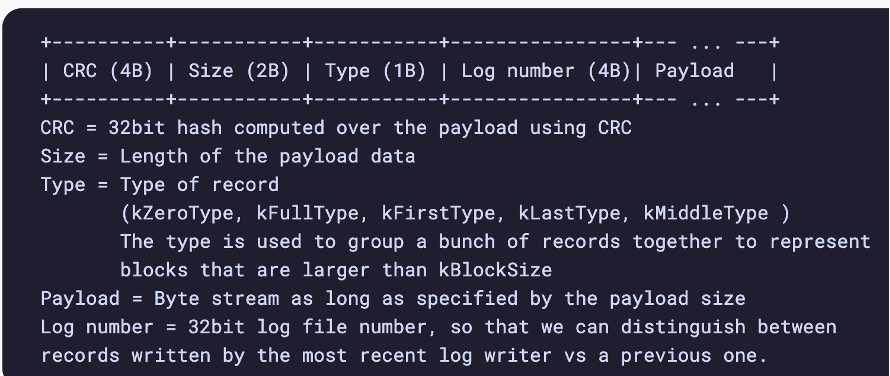Components
- 3 components - MemTable, SSTable, WAL
- MemTable
- Sorted Map - i.e. map sorted by key
- Actually unsure if it's a map or a list...some places say list, which would make more sense on Binary Search to find + need to write in certain areas
- Any new record is immediately written to in-memory MemTable
- Max capacity, usually is 2MB, but can be anything (within reason)
- When capacity is reached, records are flushed to disk
- 3 routines:
- Add a record to list
- Sorting records
- Find record using Binary Search
- WAL (Write Ahead Log)
- RAM objects are now persistent or durable - WAL helps us maintain that promise
- Append only, immutable log file, that every record operation on MemTable is appended into
- Set, Update, or Delete is appended to log
- If node goes down, WAL can be used to re-create MemTable
- Once MemTable is full and written to disk, corresponding WAL is deleted
- SSTable
- When a MemTable is flushed to disk, we take that Sorted Run and store it on disk as an SSTable
- i.e. when we want to write MemTable to disk, we store it as an SSTable
- SSTables are organized into levels with max capacities of powers
- 10MB, 100MB, etc...
- Whenever any level reaches capacity, it's Compacted into next level
- This means older records will persist on disk in older SSTables until updated
- Compaction
- Our garbage collection and data management process of our database
- Compaction takes SSTable from filled level and merges it with SSTables in next level with overlapping key ranges
- When files are merged we:
- Re-sort keys
- Outdated records are removed
- New SSTable is created
- API's
- GET - This should search MemTable, and then earliest to oldest levels (lowest to highest) to find the latest record
- SET - Should set it into MemTable, which updates WAL, which eventually makes into SSTable levels once capacity is reached
- DELETE - Inserts a Tombstone into the MemTable
- GET that receives a Tombstone means no record / was deleted
- When Tombstone goes down to lower SSTables it would take precedence over regular values
- SCAN - Collects all records between low_key and high_key
- GET(low_key) and iterate until iterator > high_key
- Most likely have to scan multiple SSTables at different levels
Implementation
- MemTable
- Can be any sort of container that supports sorting keys, and scanning retrieval
- Insert and search can both be O(logn) with a simple Vector
- RocksDB uses a Skip List which is a Linked List with multiple other links that you can use to skip
- Skip Lists still have, on average, O(logn) search without O(n) insert which can happen with a Vector if it's full
- Can't use a Hash Map because scans would be O(n)
- Since we write to MemTable in O(logn) in RAM, and then write this to disk as SSTable later on, writes are fast
- Still durable because of WAL
- We remove need for random disk writes which is how B-Tree would handle it
- WAL
- On disk backup for MemTable
- Just an append only log of transactions
- Uses Sequential I/O and not Random I/O
- Sequential I/O is faster, but uses up a lot of disk space because each time a record is updated older versions are kept
- Space Amplification is the amount of disk space per actual database - so if a 1GB Dataset uses 2GB of disk space, it's space amplification is 2
- Buffered I/O
- Disks can't keep up with request needs
- Portions of disk are brought into memory, changes happen in memory, and occasionally the memory is written back to disk via OS
- We write data to a buffer that's eventually flushed to disk
- "Thousands of times faster as synchronous disk writes via Unbuffered I/O"
- SSTable
- When a MemTable is flushed to disk, we take that Sorted Run and store it on disk as an SSTable
- i.e. when we want to write MemTable to disk, we store it as an SSTable
- SSTables are organized into levels with max capacities of powers
- 10MB, 100MB, etc...
- Whenever any level reaches capacity, it's Compacted into next level
- This means older records will persist on disk in older SSTables until updated
- Compaction
- Our garbage collection and data management process of our database
- Compaction takes SSTable from filled level and merges it with SSTables in next level with overlapping key ranges
- When files are merged we:
- Re-sort keys
- Outdated records are removed
- New SSTable is created
- All buffered writes are lost if OS crashes
- Unbuffered I/O writes data directly to physical disk
- RocksDB has a straight append only log
- Each operation stored in a block of 32KB
- Records larger than 32KB stored in multiple blocks
- Start of block is a checksum to verify integrity

Optimizations
- Bloom Filters
- Indexing (index of index)
- B+Tree
